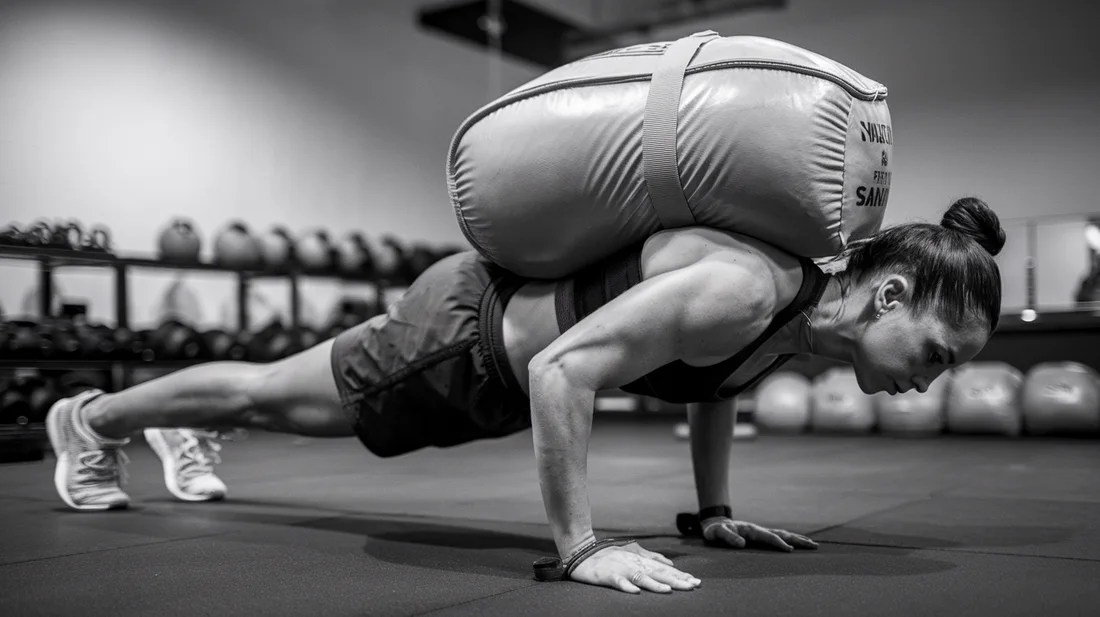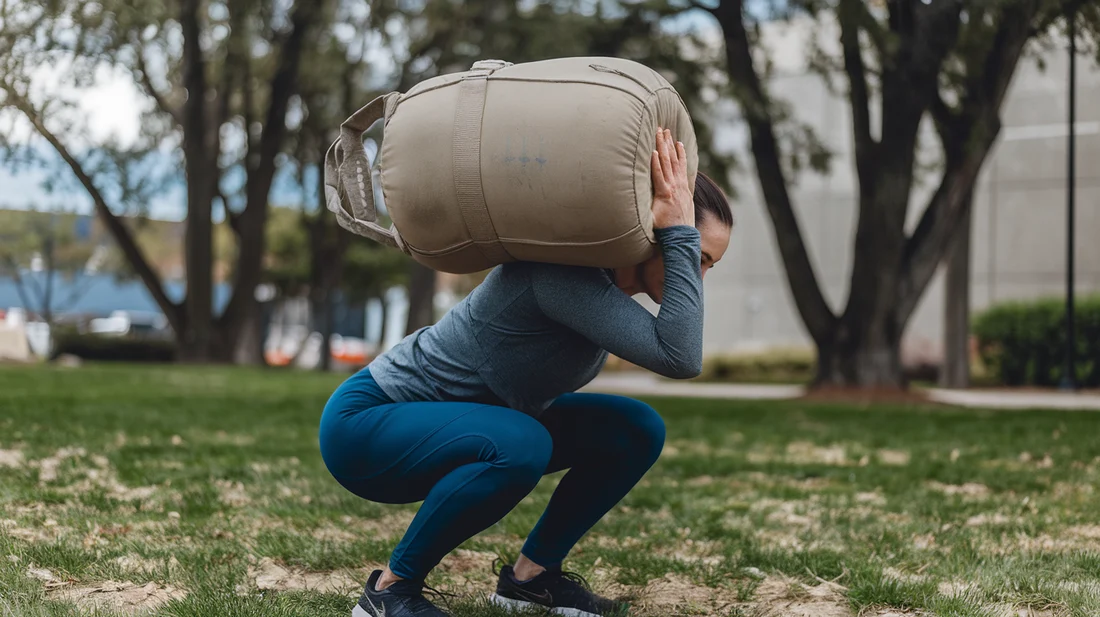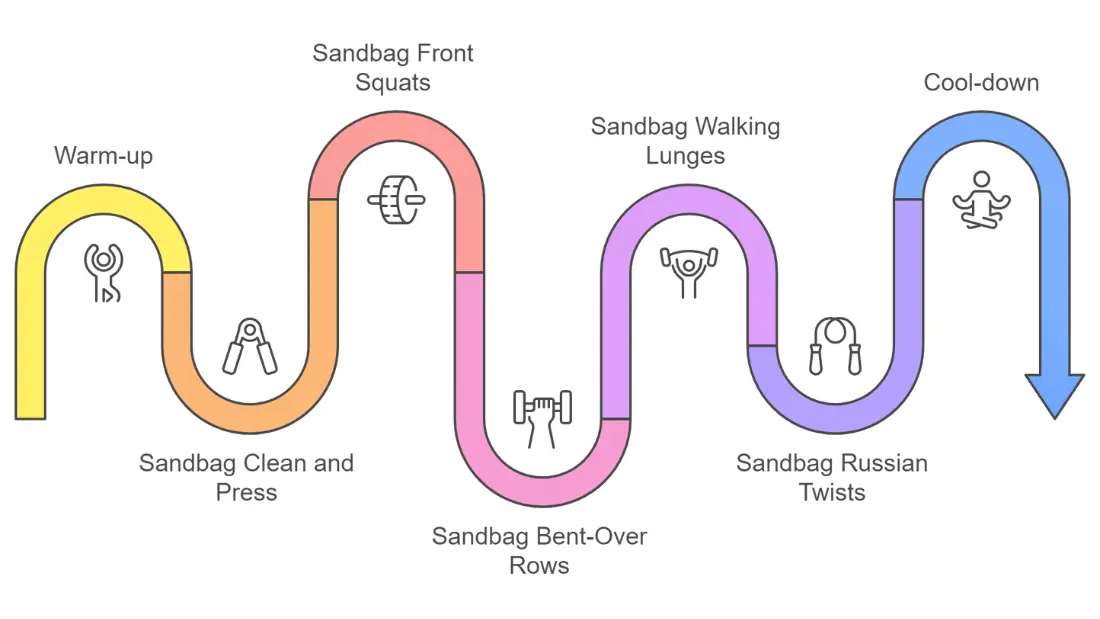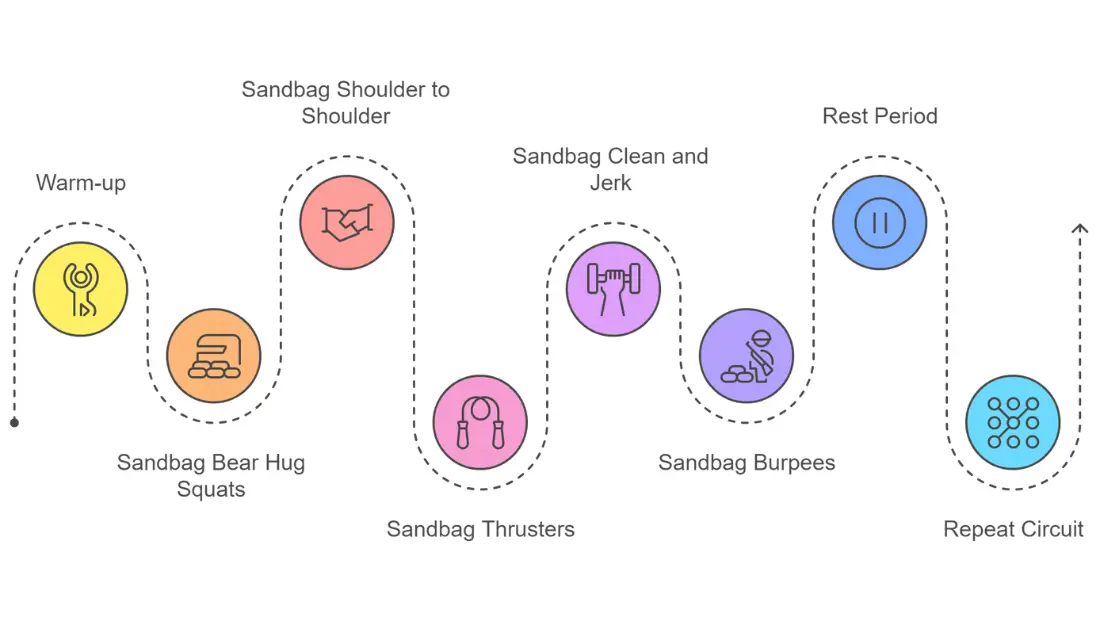Imagine lifting a weight that fights back – shifting, challenging, and constantly engaging your muscles in ways that traditional weights never could.
This is the fascinating science behind sandbag training, a revolutionary approach that’s reshaping how we think about strength and stability.

While perfectly aligned barbells and carefully engineered machines dominate modern gyms, there’s something remarkably effective about training with an implement that’s deliberately unstable.
Did you know that elite military units and professional athletes have long used sandbag training as a cornerstone of their strength programs?
It’s not just about the weight – it’s about how that weight behaves.
Unlike traditional training methods that often isolate muscles in predictable patterns, sandbag training engages your body in a way that mirrors real-world challenges.
But here’s the problem, despite spending countless hours in the gym, many fitness enthusiasts find themselves strong in the weight room yet struggling with everyday tasks like moving furniture or carrying groceries.
This disconnect between gym strength and functional fitness has led researchers and fitness experts to examine the science behind sandbag training more closely.
In this comprehensive guide, we’ll dive deep into:
- The biomechanics that make sandbag training uniquely effective
- How unstable load training activates more muscle fibers than traditional weights
- Scientific evidence supporting the benefits of sandbag training
- Practical applications for both beginners and advanced athletes
Whether you’re an experienced athlete looking to enhance your functional strength or someone seeking a more effective training method, understanding the science behind sandbag training will revolutionize your approach to fitness.
Let’s explore why this ancient training method is making waves in modern exercise science.
Benefits of Sandbag Training

Sandbag training offers a unique blend of versatility, functional strength, and metabolic benefits.
Let’s delve into the key advantages:
Versatility
- Wide Range of Exercises: From squats and deadlifts to presses and carries, sandbags offer endless possibilities.
- Adaptable to All Fitness Levels: Beginners and advanced athletes alike can find suitable challenges.
Functional Strength
- Real-World Application: Sandbags mimic real-life movements, enhancing everyday strength and reducing injury risk.
- Core Engagement: The unstable nature of sandbags forces your core to stabilize, leading to improved balance and posture.
Metabolic and Conditioning Benefits
- Calorie Burn: Sandbag training elevates your heart rate and boosts metabolism, leading to increased calorie expenditure.
- Enhanced Cardiovascular Health: Regular sandbag workouts can improve heart health and endurance.
Portability and Affordability
- Train Anywhere: Sandbags are easy to transport, allowing you to workout at home, the gym, or outdoors.
- Cost-Effective: Sandbags are a budget-friendly investment compared to traditional gym equipment.
By incorporating sandbag training into your routine, you can experience a holistic approach to fitness that delivers results.
Unleashing the Science of Sandbag Training

Neuromuscular Coordination
- Unstable Loads, Enhanced Learning: Sandbags force your brain to adapt to constant changes, leading to improved neural pathways and quicker reaction times.
- Enhanced Muscle Activation: This unique training method can increase muscle fiber recruitment by up to 30% compared to traditional weights.
Core Stability
- 3D Core Activation: Sandbags engage your core muscles from multiple angles, strengthening your core and improving stability.
- Enhanced Proprioception: By constantly adapting to the shifting weight, your body’s awareness of its position in space improves.
Functional Strength
- Real-World Application: Sandbags mimic real-life movements, translating to improved performance in everyday activities and sports.
- Increased Power Output: By challenging your muscles in new ways, sandbag training can boost your power and explosiveness.
Key Takeaway
Sandbag training offers a comprehensive approach to fitness, combining strength, stability, and functional movement.
By understanding the science behind this unique training method, you can unlock your full potential and achieve your fitness goals.
Advanced Sandbag Training Techniques

To take your sandbag training to the next level, consider these advanced techniques:
High-Intensity Protocols
- HIIT Workouts: Incorporate sandbags into high-intensity interval training for maximum calorie burn and muscle gain.
- Tabata and AMRAP: These time-based workouts push you to your limits, enhancing your cardiovascular fitness and endurance.
Variety of Exercises
- Complex Movements: Expand your repertoire with exercises like cleans and presses, rotational deadlifts, and sandbag bear complexes.
- Functional Training: Mimic real-world movements to build practical strength and improve daily performance.
Progressive Overload
- Increase Weight: Gradually add more weight to challenge your muscles.
- Increase Reps and Sets: Continuously challenge your body with higher volume.
- Reduce Rest Periods: Shorten rest times to increase intensity.
- Complex Movements: Combine multiple exercises into one fluid movement.
By incorporating these techniques into your routine, you can unlock your full potential and achieve significant fitness gains.
Remember to prioritize proper form and listen to your body to avoid injury.
Sample Workout Routines
To help you get started with sandbag training, we’ve put together a variety of workout routines tailored to different experience levels.
Whether you’re a beginner taking your first steps into functional strength training, an intermediate athlete looking to elevate your workouts, or an advanced practitioner seeking high-intensity challenges, these routines will guide you to success.
Beginner Routine – Build Your Foundation

Warm-up: 5-10 minutes of dynamic stretching (e.g., arm circles, leg swings, bodyweight squats)
Workout:
- Sandbag Shoulder Carry: 3 sets of 30-60 seconds per side
- Sandbag Squats: 3 sets of 10-15 reps
- Sandbag Deadlifts: 3 sets of 10-12 reps
- Sandbag Overhead Press: 3 sets of 8-10 reps
- Sandbag Plank: 3 sets of 20-30 seconds
Cool-down: 5-10 minutes of static stretching
Remember: Prioritize proper form and listen to your body. As you progress, gradually increase the weight of your sandbag or the number of repetitions.
Intermediate Routine – Elevate Your Training

Warm-up: 5-10 minutes of dynamic stretching and mobility exercises
Workout:
- Sandbag Clean and Press: 3 sets of 8-10 reps
- Sandbag Front Squats: 3 sets of 10-12 reps
- Sandbag Bent-Over Rows: 3 sets of 10-12 reps
- Sandbag Walking Lunges: 3 sets of 10-12 reps per leg
- Sandbag Russian Twists: 3 sets of 12-15 reps per side
Cool-down: 5-10 minutes of static stretching and deep breathing
Remember: As you progress, consider increasing the weight of your sandbag or the number of repetitions and sets to continue challenging your body.
Advanced Routine – High-Intensity Sandbag Circuit

Warm-up: 10 minutes of dynamic stretching and mobility drills
Workout:
Perform the following circuit 3-4 times, resting 2-3 minutes between rounds:
- Sandbag Bear Hug Squats: 45 seconds
- Sandbag Shoulder to Shoulder: 45 seconds
- Sandbag Thrusters: 45 seconds
- Sandbag Clean and Jerk: 45 seconds
- Sandbag Burpees: 45 seconds
Cool-down: 5-10 minutes of static stretching
Remember: This is a challenging workout. Listen to your body and adjust the duration or intensity as needed.

Key Tips for Sandbag Training
- Prioritize Form: Focus on proper form to maximize results and minimize injury risk.
- Listen to Your Body: Adjust your workouts based on your body’s needs.
- Stay Hydrated: Drink plenty of water to optimize performance.
- Progressive Overload: Continuously challenge yourself by gradually increasing the weight or intensity.
- Sandbag Selection: Choose a sandbag that suits your fitness level and exercise goals.
- Grip Strength: Develop strong grip strength to handle the weight effectively.
- Core Engagement: Maintain a strong core throughout all movements.
- Exercise Variety: Incorporate diverse exercises to target different muscle groups and prevent boredom.
By following these tips, you can make the most of your sandbag training and achieve your fitness goals.
Frequently Asked Questions About Sandbag Training
Getting Started
- What weight should I start with? Start with a weight that challenges you without compromising form.
- How do I choose a sandbag? Consider factors like quality, handle positions, weight capacity, and size.
Training and Programming
- How often should I train? 2-3 times per week for beginners, 3-4 times for intermediate, and 4-5 times for advanced.
- Can I replace traditional weights? Yes, sandbags offer a versatile and effective way to train, but consider combining them with traditional weightlifting for optimal results.
Safety and Form
- What are common mistakes? Avoid using excessive weight, poor form, and neglecting warm-ups.
- How can I prevent injuries? Prioritize proper form, gradual progression, and adequate rest.
Integration and Progress
- How do I incorporate sandbags into my routine? Dedicate specific days, supplement existing workouts, or replace similar exercises.
- How quickly will I see results? Consistent training, proper nutrition, and rest will lead to noticeable improvements in strength, stability, and endurance.
Equipment and Maintenance
- How do I maintain my sandbag? Store it in a dry place, check for damage, and clean it regularly.
- What type of sand should I use? Play sand, pea gravel, or rubber mulch are good options.
Advanced Training
- How do I break through plateaus? Vary your routine, increase intensity, and experiment with unstable surfaces.
- Can I use sandbags for sport-specific training? Absolutely! Sandbag training can enhance power, strength, and sport-specific movements.
By following these guidelines and incorporating sandbag training into your routine, you can unlock your full potential and achieve your fitness goals.
Common Concerns and Solutions
| Concern | Solution |
|---|---|
| Lack of Variety | Incorporate a wide range of exercises, including dynamic movements, static holds, and plyometrics. |
| Plateauing | Increase weight, reps, or sets. Try different rep ranges or rest periods. |
| Soreness and Recovery | Prioritize proper warm-up and cool-down. Use foam rolling and stretching to aid recovery. |
| Motivation | Set specific goals, track your progress, and find a training partner to stay motivated. |
By addressing these additional concerns, you can further optimize your sandbag training experience and achieve your fitness goals.
Key Takeaways – The Power of Sandbag Training
Sandbag training offers a unique blend of versatility, effectiveness, and accessibility.
Here’s why it should be part of your fitness routine:
- Functional Strength: Sandbags mimic real-world movements, building practical strength for everyday activities.
- Core Stability: The shifting weight challenges your core, improving balance and stability.
- Metabolic Boost: High-intensity sandbag workouts can increase calorie burn and enhance cardiovascular health.
- Versatility: Sandbags offer a wide range of exercises to suit various fitness levels and goals.
- Accessibility: They’re affordable, portable, and easy to incorporate into any workout routine.
Whether you’re a beginner or an advanced athlete, sandbag training can help you achieve your fitness goals.
So, grab a sandbag and start reaping the benefits today!
Real Experiences with Sandbag Training
- Alex R., Fitness Enthusiast: “Sandbag training has transformed my workouts, boosting my strength and core stability.”
- Jessica L., Personal Trainer: “Sandbags offer a unique challenge that traditional weights can’t match.”
- Michael T., Competitive Athlete: “Sandbag training has enhanced my athletic performance and functional strength.”
- Sarah J., Busy Mom: “Sandbag workouts are convenient, effective, and fun for the whole family.”
- David P., College Student: “Sandbags are an affordable and effective way to build strength and improve fitness.”
Why Sandbag Training Works
- Versatility: A wide range of exercises for all fitness levels.
- Functionality: Real-world strength and performance improvements.
- Affordability: Cost-effective and portable.
Join the growing community of sandbag enthusiasts and experience the transformative power of this unique training method.
Conclusion
Sandbag training offers a versatile and effective approach to fitness, empowering you to build functional strength, enhance core stability, and boost your metabolism.
Its unique combination of instability and resistance challenges your body in ways that traditional weightlifting cannot.
Whether you’re a beginner or an advanced athlete, sandbags can elevate your workouts.
They’re portable, affordable, and adaptable to various fitness goals.
So, grab a sandbag and start your journey to a stronger, fitter you.
TL;DR
Sandbag training is a versatile and effective way to:
- Build functional strength
- Improve core stability
- Boost metabolism
- Enhance athletic performance
Ready to transform your fitness? Start your sandbag training journey today!
Sources
- Juniper Publishers: “The Science of Powerbag Training” – This study provides detailed insights into the benefits of sandbag training, including core and hip muscle engagement, dynamic resistance, and its application in various sports and fitness contexts.
- PubMed: “Effects of 12-Week Progressive Sandbag Exercise Training on Patients with Type 2 Diabetes Mellitus” – This study highlights the benefits of sandbag training for patients with T2DM, including improved muscle strength and blood sugar control.
- Digital Commons at SUNY Cortland: “Differences in muscle activation while gripping a sandbag versus an Olympic weightlifting bar” – This study compares the muscle activation between gripping a sandbag and an Olympic weightlifting bar, showing greater activation in the hands and forearms with sandbags.
- Ultimate Sandbag Training: “Ground Breaking Ultimate Sandbag Training Study” – This article discusses a study on the metabolic and strength benefits of Ultimate Sandbag Training, including its comparison to running in terms of caloric burn and post-exercise metabolic stimulus.
- Men’s Health: “Find Out Why Sandbags Build Strength Like Nothing Else” – This article provides an overview of the benefits of sandbag training, including its effectiveness in building core strength, grip strength, and overall functional fitness, along with practical tips for incorporating sandbags into a workout routine.



